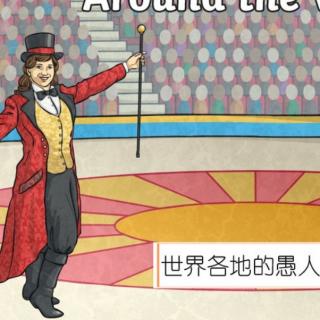
介绍:
世界各地的愚人习俗和文化
How Did April Fools' Day Begin?
愚人节的由来.
April Fool's Day:愚人节
April: 四月
fool: 傻瓜
Begin:开始
Until the 15th century(世纪), the first day of the new year was 1st April. In 1582, Pope Gregory XIII changed the calendar(日历) to the Gregorian calendar, which meant the first day of the new year was changed to 1st January. Anyone who continued to celebrate(庆祝) new year on 1st April was considered a fool!
15世纪前,新年的第一天是4月1日。1582年,教皇格里高利十三世将历法改为公历,即新年的第一天改为1月1日。所以,任何还在4月1日这天继续庆祝新年的人都被认为是傻瓜!
until: 直到...才
the first day: 第一天
the new year: 新年
XIII:罗吗数词X代表10,V代表5,III代表三
continue to: 继续
be consedered: 被认为
United Kingdom 英国
in the UK, April Fools' Day is a chance to play a trick or prank on an unsuspecting person. Traditionally, pranks should be carried out by midday(中午). It is thought that anyone playing a prank after this time, is in fact the fool themselves.
在英国,愚人节是一个有机会捉弄人或恶作剧的日子。传统上,恶作剧应该在中午之前。人们认为,如果任何人还在这之后玩恶作剧的话,其实就是愚弄自己。
play a trick/prank: 玩恶作剧
carry out: 实施,开展
France法国
In France, April Fools'Day is called 'Poisson d'Avril', which means 'April Fish'. April 1st falls during Lent(大斋节), and meat is not supposed to be eaten during this time, so instead fish is a preferred food. Therefore, on this day, a joker will tape a paper fish to the back of a classmate or friend and wait for the joke to be noticed!
在法国,愚人节被称为“Poisson d'Avril”,意思是“四月鱼”。四月一日是大斋节,这段时间不应该吃肉,所以鱼是首选食物。因此,在这一天,开玩笑的人会把一条纸鱼贴在同学或朋友的背上,等待笑话或被注意到!
be supposed to: 应该
preferred food:首选食物
the back of ...在...后面
wait for:等待
Scotland苏格兰
Traditionally, in Scotland, this day was called 'Hunt the Gowk'. 'Gowk' is a Scottish word that means 'cuckoo'. It is a day to send someone on a fool's errand. This means you send someone to look for something that doesn't exist like hens' teeth or a tin of tartan paint.
传统上,在苏格兰,这一天被称为“猎狗节”Gowk是一个苏格兰方言,意思是“布谷鸟”。这是派某人去办傻事的日子。意思是说你要派人去寻找像母鸡的牙齿或一罐格子漆一样不存在的东西。。
errand: 差事
look for: 寻找
a tin of:一罐
tartan:格子呢
Portugal葡萄牙
In Portugal, the traditions of April Fools' Day last for two days on the Sunday and Monday before Lent. One of the main Portuguese pranks is to throw flour on someone.
在葡萄牙,愚人节的传统在四旬斋前的周日和周一持续两天。葡萄牙人的一个主要恶作剧就是往别人身上撒面粉。
Portugal [ˈpɔːtʃəgəl]:葡萄牙
Portuguese[ˌpɔːtʃuˈɡiːz]:葡萄牙人
last for: 持续
flour:面粉
India印度
In India, the festival of Holi is celebrated on 31st March. This is a day to play jokes and throw coloured powder around to welcome the season of spring.
在印度,胡里节是在3月31日庆祝的。这是一个开玩笑、到处撒彩粉迎接春天的日子。
play jokes:开玩笑
Iran伊朗
In Iran, the 13th day of the Persian new year is called 'Sizdah Bedar'. Pranks have been played there since 536BC making it the oldest known joke day in the world. It is traditional to celebrate the day by having a picnic and playing games. Then after the picnic, all the leftover green vegetables are thrown away. This represents getting rid of bad luck for the coming year.
在伊朗,波斯新年的第13天被称为“Sizdah Bedar”。自公元前536年起,这里就开始了恶作剧,成为世界上已知最古老的笑话日。传统的庆祝方式是去野餐和玩游戏。野餐后,所有剩下的绿色蔬菜都会被扔掉,这代表着来年会摆脱厄运。
the oldest:最古老的,年龄最大的
in the world:全世界
have a picnic:野餐
play games:玩游戏
throw away: 扔掉
get rid of: 摆脱
bad luck: 厄运
the coming year: 来年
Germany德国
German people call this day 'Aprilscherz' and it is a day to play tricks on family, colleagues and friends. Even some white lies are excused on this day. The media also usually or report on a fictitious story to try and play a trick on the German public.
德国人称这一天为“四月日”,是捉弄家人、同事和朋友们的日子。即使是善意的谎言在这一天也是可以原谅的。媒体通常也会发布或报道一个虚构的故事,试图欺骗德国公众。
white lies: 善意的谎言
大家还在听

